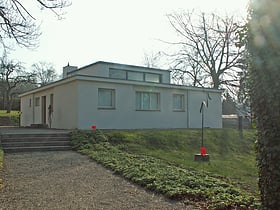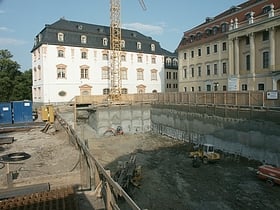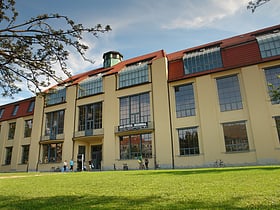Weimar: Sightseeing
Places and attractions in the Sightseeing category
Categories
More categoriesSchloss Belvedere
Baroque palace and large landscaped park Nestled in the charming city of Weimar, Schloss Belvedere is a baroque masterpiece that beckons visitors with its historical elegance and architectural grandeur. This castle, situated just a few kilometers outside the city center, offers a glimpse into the opulent past...
Stadtschloss
The Stadtschloss Weimar, nestled in the heart of the culturally rich city of Weimar, Germany, is a historical castle that offers visitors a journey through time. This grand structure, which has been a pivotal part of Weimar's landscape, dates back to the early 16th...
Goethes Gartenhaus
Goethe's Garden House in the Park an der Ilm zu Weimar was a place of residence and work of Johann Wolfgang von Goethe. It has been a UNESCO World Heritage Site since 1998 as part of the "Classical Weimar" ensemble.
Park an der Ilm
Nestled in the heart of Weimar, Germany, the Park an der Ilm is a verdant oasis that offers a tranquil escape from the bustling city life. This picturesque park, sprawling along the banks of the Ilm River, is a testament to the natural beauty and historical...
Schloß Tiefurt
Nestled in the cultural city of Weimar, Germany, Schloß Tiefurt, also known as Tiefurt House, is a charming historical site that offers a glimpse into the rich heritage of the region. This elegant manor house, surrounded by an idyllic park, was once a summer residence...
Bauhaus-Museum
The Bauhaus-Museum in Weimar, Germany, stands as a testament to the revolutionary Bauhaus movement that has left a lasting impact on art, design, and architecture worldwide. Founded in 1919 by Walter Gropius, the Bauhaus school merged fine arts with crafts, leading...
Classical Foundation Weimar
The Klassik Stiftung Weimar is one of the largest and most significant cultural institutions in Germany. It owns more than 20 museums, palaces, historic houses and parks, as well as literary and art collections, a number of which are World Heritage Sites.
Goethe House
The Goethe House is the main house lived in by the writer, poet, and statesman Johann Wolfgang von Goethe whilst in Weimar, Germany, though he did live in several others in the town. The home serves as the main location of the Goethe-Nationalmuseum.
Goethe–Schiller Monument
Iconic statue of 2 German writers The original Goethe–Schiller Monument is in Weimar, Germany. It incorporates Ernst Rietschel's 1857 bronze double statue of Johann Wolfgang Goethe and Friedrich Schiller, who are probably the two most revered figures in German literature.
Goethe-Nationalmuseum
The Goethe-Nationalmuseum is a museum devoted to the German author Johann Wolfgang von Goethe, in the town of Weimar in Germany.
Deutsches Nationaltheater und Staatskapelle Weimar
The Deutsche Nationaltheater und Staatskapelle Weimar is a German theatre and musical organisation based in Weimar. It is a twin institution, consisting of the theatrical Deutsches Nationaltheater and the symphony orchestra known as the Staatskapelle Weimar.
Haus am Horn
UNESCO-listed Bauhaus building The Haus am Horn is a domestic house in Weimar, Germany, designed by Georg Muche. It was built for the Bauhaus Werkschau exhibition which ran from July to September 1923.
Church of Sts. Peter and Paul
The church of St Peter and Paul in Weimar, Germany, is also known as Herderkirche after Johann Gottfried Herder. It is the most important church building of the town, and is called Stadtkirche, opposed to the courtly Schloßkirche.
Duchess Anna Amalia Library
Court library with an ornate Rococo hall The Duchess Anna Amalia Library in Weimar, Germany, houses a major collection of German literature and historical documents and is part of the UNO designated Classical Weimar.
Russian Orthodox Chapel
The Russian Orthodox Chapel is a funerary chapel built in Weimar in 1860 for Grand Duchess Maria Pavlovna of Russia. It was constructed in the Historical Cemetery behind the Weimarer Fürstengruft, to which it is connected by an underground passage.
Nietzsche-Archiv
The Nietzsche Archive is the first organization that dedicated itself to archive and document the life and work of the philosopher Friedrich Nietzsche, all sourced from Elisabeth Förster-Nietzsche, the philosopher's sister.
Bauhaus Museum Weimar
The Bauhaus Museum Weimar is a museum dedicated to the Bauhaus design movement located in Weimar, Germany. It presents the Weimar collections of the State Bauhaus, which was founded in the town in 1919. The museum is a project of the Klassik Stiftung Weimar and is located near the Weimarhallenpark.
Monument to the March Dead
Monument to the March Dead is an expressionist monument in the Weimar Central Cemetery in Weimar, Germany that memorializes workers killed in the 1920 Kapp Putsch.
Bauhaus University
The Bauhaus-Universität Weimar is a university located in Weimar, Germany, and specializes in the artistic and technical fields. Established in 1860 as the Great Ducal Saxon Art School, it gained collegiate status on 3 June 1910.
University of Music Franz Liszt Weimar
The University of Music Franz Liszt Weimar is an institution of music in Weimar, Germany.
Bauhaus and its Sites in Weimar
Bauhaus and its Sites in Weimar, Dessau and Bernau is a joint World Heritage Site in Germany, comprising six separate sites which are associated with the Bauhaus art school.
Klassik Stiftung Weimar
The Klassik Stiftung Weimar is one of the largest and most significant cultural institutions in Germany. It owns more than 20 museums, palaces, historic houses and parks, as well as literary and art collections, a number of which are World Heritage Sites.
Jacobsfriedhof
The Jacobsfriedhof, also known as the Jakobskirchhof, is the oldest extant burial ground in Weimar, Thuringia, Germany, on land round the Jakobskirche. The first burials took place here as early as the 12th century.
Gedenkstätte Buchenwald
Nazi and Soviet concentration camp site Buchenwald was a Nazi concentration camp established on Ettersberg hill near Weimar, Germany, in July 1937. It was one of the first and the largest of the concentration camps within Germany's 1937 borders.
Museum für Ur-und Frühgeschichte
The Museum of Prehistory and Early History of Thuringia in Weimar combines a museum with a 1000 m² exhibition area and the Thuringian State Office for the Preservation of Monuments and Archaeology under one roof, which is the sponsor of the museum.
Wittumspalais
The Wittumspalais is a museum in Weimar operated by the Klassik Stiftung Weimar. The building was the longtime widow's residence of Duchess Anna Amalia and formed a center of social and literary life in Weimar during her lifetime.
Sankt Christophorus
The Evangelical Lutheran Church of St. Christopher stands in the Tiefurt district of the city of Weimar in Thuringia. It belongs to the Weimar parish in the Weimar parish district of the Evangelical Church in Central Germany and is historically...
Haus Hohe Pappeln
The house "Hohe Pappeln" is the former home of Henry van de Velde in Weimar and is now used as a museum by the Klassik Stiftung Weimar.
Roman House
The Roman House is a building on the edge of the Park on the Ilm River in Weimar and has been a UNESCO World Heritage Site since 1998 as part of the "Classical Weimar" ensemble.
Classical Weimar
Classical Weimar is a UNESCO World Heritage Site consisting of 11 sites related to Weimar Classicism located in and around the city of Weimar, Germany. The site was inscribed on 2 December 1998.
Map









































